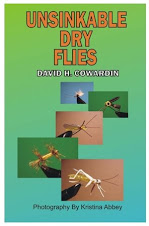Recipe Rated-X Damsel Fly
Front Fly
- Hook – 4 or 6X Long Shank, Size
10
- Thread – 6/0 Blue
-
Eyes 1/8 inch black round foam
- Body – 1/8 inch Blue Heat
Shrink Tubing
-
Collar – Grizzly Hackle (optional)
- Wing – Web Wing or similar (Clear
with black ribbing)
- Legs – Black and White
Rubber or Brown Mono
Rear Fly
- On the same
hook
- Thread – 6/0 Blue
-
Eyes 1/8 inch black round foam
- Body – 3/32 inch Clear Heat
Shrink Tubing colored with blue alcohol ink
-
Collar – Grizzly Hackle (optional)
- Wing – Web Wing or similar (Clear
with black ribbing)
- Legs – Black and White
Rubber or Brown Mono
This fly is great on any water where damsel flies are
present. Fish this fly in calmer water especially under
overhanging bushes and trees.















